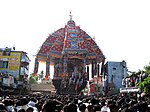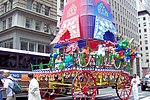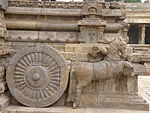Ratha
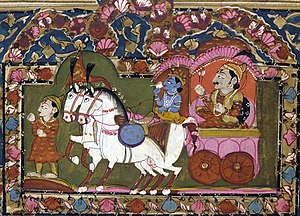
Ratha (
Harappan Civilisation

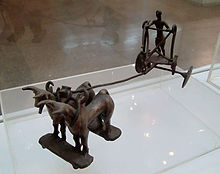
The
During the Harappan Period (Harappa Phase, 2600–1900 BC) there was a dramatic increase in the terracotta cart and wheel types at Harappa and other sites throughout the Indus region. The diversity in carts and wheels, including depictions of what may be spoked wheels, during this period of urban expansion and trade may reflect different functional needs, as well as stylistic and cultural preferences. The unique fonts and the early appearance of carts in the Indus valley region suggest that they are the result of indigenous technological development and not diffusion from West Asia or Central Asia as proposed by earlier scholars.[2]
The earliest Copper-Bronze Age carts remains that have been found at Sinauli have been dated to 1900 BCE, which were interpreted by some as horse-pulled "chariots", predating the arrival of the horse-centred Indo-Aryans.[3][4][5] Others object, noting that solid wheels belong to carts, not chariots.[3][4]
Indo-Aryans
Proto-Indo-Iranians
Horse-drawn chariots, as well as its cult and associated rituals, were spread by the Indo-Iranians,[6] and horses and horse-drawn chariots were introduced in India by the Indo-Aryans.[7][8][9][note 1]
The earliest evidence for chariots in southern
Textual evidence

Chariots figure prominently in the
Chariots also feature prominently in later texts, including the other Vedas, the Puranas and the great epics of the Ramayana and Mahabharata. Indeed, most Hindu deities are portrayed as riding them. Among Rigvedic deities, notably Ushas "Dawn" rides in a chariot, as well as Agni in his function as a messenger between gods and men. In RV 6.61.13, the Sarasvati River is described as being wide and speedy like a chariot.
Remains
There are a few depictions of chariots among the
In Hindu temple festivals
Ratha or Rath also means a large, often very large, wheeled cart made of wood, on which the
- Ratha or chariots
-
The Rath Jatra in the Grand Avenue at the Jagannath Temple, Puri, 2007.
-
The Towering Rajagopuram with one of the Temple Rathas
-
Tiruvarur
-
The Rath Yatra in Puri in modern times showing the three chariots of the deities with the Templein the background
-
Picture of Tirunelveli Nellaiappar Temple Golden Ratha
-
ISKCON Rath Yatra at Thiruvananthapuram, India.
-
Tiruvarur The largest Temple Ratha car in Tamil Nadu
-
Srivilliputtur Andal Ther - 2nd largest Temple Rath in Tamil Nadu
-
Tirunelveli Nellaiappar Temple Car - 3rd largest Temple Ratha in Tamil Nadu
-
Rath Yatra festival inISKCON
-
Construction of ratha
-
Banashankari Amma Temple's wooden Ratha, Badami, Karnataka
-
Decorated Ratha, Mundkur, Udupi District, Karnataka.
-
Chariot of Jagadishpur, in West Bengal.
Rathas buildings
In some
The most known are the
Another example is the
- Buildings
-
'Five Rathas' at Mamallapuram, Tamil Nadu.
-
Temple chariot of the Airavatesvara Temple in Darasuram, Tamil Nadu
-
Konark Sun Temple Ratha wheel
Rathas in architecture

In Hindu temple architecture, a ratha is a facet or vertical offset projections on the tower (generally a Shikhara).
See also
- Ashva
- History of the horse in the Indian subcontinent
- Types of carriages
- Rathera (sport)
Notes
- ^ According to Raulwing, the chariot must not necessarily be regarded as a marker for Indo-European or Indo-Iranian presence.[10] According to Raulwing, it is an undeniable fact that only comparative Indo-European linguistics is able to furnish the methodological basics of the hypothesis of a "PIE chariot", in other words: "Ausserhalb der Sprachwissenschaft winkt keine Rettung![11] "[12][13]
References
- ^ Bryant 2001
- ^ Kenoyer, Jonathan Mark (2004), "Die KalTen der InduskuItur Pakistans und Indiens" [Wheeled Vehicles of the Indus Valley Civilization of Pakistan and India], in Fansa, M.; Burmeister, S. (eds.), Rad und Wagen: Der Ursprung einer Innovation Wagen im Vorderen Orient und Europa [Wheel and Wagon - origins of an innovation], Verlagg Philipp von Zabem, retrieved 23 January 2015 – via a.harappa.com
- ^ a b Witzel 2019, p. 5.
- ^ a b Parpola 2020.
- ^ Daniyal 2018.
- ^ Kuz'mina 2007, p. 321-322.
- ^ Flood 1996, p. 34.
- ^ Witzel 2019, p. 12, 21.
- ^ Olson 2007, p. 11.
- ^ Cf. Raulwing 2000
- ^ I. e., "Outside of linguistics there's no hope."
- ^ Raulwing 2000:83
- ^ Cf. Henri Paul Francfort in Fussman, G.; Kellens, J.; Francfort, H.-P.; Tremblay, X. (2005), p. 272-276
- H. P. Francfort, Fouilles de Shortugai, Recherches sur L'Asie Centrale Protohistorique Paris: Diffusion de Boccard, 1989, p. 452. Cf. Henri Paul Francfort in Fussman, G.; Kellens, J.; Francfort, H.-P.; Tremblay, X. (2005), p.272
- ^ H. P. Francfort in Fussman, G.; Kellens, J.; Francfort, H.-P.; Tremblay, X. (2005), p. 220 - 272; H.-P. Francfort, Fouilles de Shortugai
- ^ A discussion of the difference between ratha and anas is found e.g. in Kazanas, Nicholas. 2001. The AIT and Scholarship
- ISBN 978-0-8239-3180-4.
Sources
- Edwin Bryant (2001). The Quest for the Origins of Vedic Culture. Oxford University Press. ISBN 0-19-513777-9
- Daniyal, Shoaib (14 June 2018). "Putting the horse before the cart: What the discovery of 4,000-year-old 'chariot' in UP signifies". Scroll.in.
- Flood, Gavin D. (1996), An Introduction to Hinduism, Cambridge University Press
- ISBN 2-86803-072-6
- Kuz'mina (2007), Mallory, J (ed.), The Origin of the Indo-Iranians, Brill, ISBN 9789047420712
- Olson, Carl (2007), The Many Colors of Hinduism: A Thematic-historical Introduction, Rutgers University Press
- Parpola, Asko (2020). "Royal "Chariot" Burials of Sanauli near Delhi and Archaeological Correlates of Prehistoric Indo-Iranian Languages". Studia Orientalia Electronica. 8: 176. .
- Peter Raulwing (2000). Horses, Chariots and Indo-Europeans, Foundations and Methods of Chariotry Research from the Viewpoint of Comparative Indo-European Linguistics. Archaeolingua, Series Minor 13, Budapest.
- Vasudha Venugopal ET bureau, https://economictimes.indiatimes.com/news/politics-and-nation/mahabharata-much-older-say-asi-archaeologists/articleshow/71658119.cms Mahabharata much older, say ASI Archaeologists , The Economic Times
- Witzel, Michael (2019), "Early 'Aryans' and their neighbors outside and inside India", Journal of Biosciences, 44 (3): 58, S2CID 195804491










